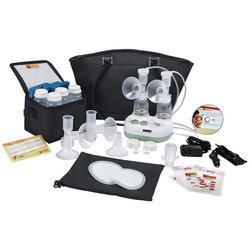The Complete Guide to Pumping Breast Milk
Exclusively breastfeeding or pumping for the first six months has multiple benefits that formula may not provide. Newborns typically need to be fed as many as 8-10 times a day; given that there are only twenty-four hours in a day, and each feeding session could take 20-30 minutes, this translates to being there for your child when he/she needs you every two hours.
If you have a partner or a caretaker, he/she can take over for some of the time while you get your much needed rest. Everyone needs to get their sleep, irrespective of whether they are lactating mothers or not. Now your partner or your caretaker cannot breastfeed your child, and anything other than breast milk is out of the question, so they need have a supply of breast milk. This can be had only if you have a breast pump which you can use to get milk out of your mammary glands when you are not nursing your newborn infant.
If you have a premature baby which cannot latch on properly to your breast, a pump might be the only solution to getting your child the nutrition he/she needs to survive.
Pumping also helps with the problem of engorged breasts - your breasts are swollen because your mammary glands produce milk in excess of what your baby needs. For other women, pumping milk regularly also stimulates milk production, so you don’t have to worry about not producing enough for your child.
What kind of pump do I need to use?
There are basically two types of pumps - those which are manually operated by hand and electric ones which are automated. Among these, there are also single-breast pumps and double-breast pumps. It could take up to 45 minutes in total with a single-breast hand pump or 15-20 minutes with a double-breast electric pump.
The electric ones are perfectly safe and mimic the action of a baby suckling at its mother’s breast. You could read a book or watch TV while it does its work, for it is important to feel relaxed for maximum output.
Storage
There are breast milk containers available in the market that you can use to store what you have pumped. It is recommended that you store breast milk according to your infant’s average intake per feeding session. For instance, if it normally consumes 3.5 oz. of milk every time, you could store milk in multiples of 3.5 oz. each. This minimizes wastage and/or avoids a situation when what you have stored isn’t enough, you need to get more for your baby.
You can store it at room temperature if it is going to be used in the next 3-6 hours, or in the fridge if it is going to take longer (please note that you would have to warm it up before use or thaw it if it has been frozen).
The best news is that you don’t have to pay for your breast pump - it can now be purchased through your
Article Reviewed By: Crystal Ibetoh MD, MBA reviews each article and ensures the accuracy of the health information. Dr. Ibetoh has strong medical interests in women's health and preventative medicine. She is also a mother of three and uses her medical expertise in addition to personal experience to provide advice about breastfeeding.
*The information provided on this site is intended for your general knowledge only and is not a substitute for professional medical advice or treatment. Please consult your healthcare provider with any questions or concerns you may have regarding breastfeeding.*

Both mother and child can reap numerous benefits from exclusive breastfeeding for the initial six months... Read More

Isn’t it everyone’s dream to burn all those calories while sitting comfortably on their lounge chair... Read More
